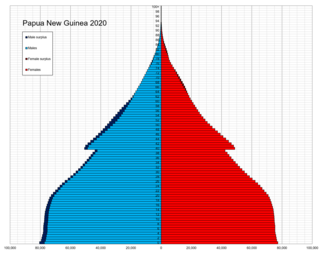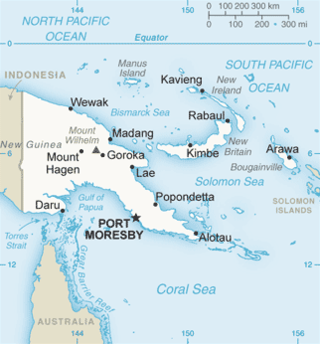Hiri is the name for the traditional trade voyages that formed an important part of the culture of the Motu people of Papua New Guinea. [1] [2]
Contents

Hiri is the name for the traditional trade voyages that formed an important part of the culture of the Motu people of Papua New Guinea. [1] [2]

The Motu live in a comparative rain shadow [3] – the dry season is unusually harsh, and there are not enough suitable areas for the growing of sago (rabia). On the other hand, the Motu, unlike most people of Papua New Guinea, were skilled in the art of making clay cooking pots (uro).
The traditional Hiri voyages carried the much-prized Motu cooking pots to the people of the Gulf of Papua, [4] [5] and brought back plentiful supplies of sago for the Motu. [6] [7]
Edai Siabo, from the village of Boera, [1] was returning from a fishing trip when a great eel appeared and dragged him under the water. [8] The eel was really the spirit of the sea. He returned Edai to the surface of the sea, after instructing him to build a great lagatoi, to fill it with cooking pots, and to sail westward, following the south-east trade wind called the laurabada in the Motu language. [8] Obeying the spirit, he built the first hiri lagatoi, named it Bogebada (which means sea-eagle), and had it loaded with pots made by his wife. He and his friends then sailed up the coast into the waters of the Gulf of Papua. [8]
For months, the Bogebada and its crew were away. The villagers were all convinced the crew had perished. They mocked Edai's wife, and tried to force her to remarry. Before Edai left, he had instructed her to stay within a corner of her house, not to bathe in the sea, to keep a tally of the days the Bogebada had been gone, to keep her fire burning, and to have her skin tattooed by an old woman. Failing to stick to this routine would endanger the expedition and the lives of Edai and his men.
One day, a lagatoi appeared on the horizon and slowly approached the village. It was Bogebada. Edai was arriving back home, a hero. His wife jumped into the sea and washed away her accumulated dirt, put on her finest costume, walked out onto the verandah of the house, hit it with a stick, shouted, ‘Hedihoroha Bogebada!’ and began dancing in joy.
Every year at the end of September or the start of October, [9] Motu men prepared their Lakatoi or lagatoi (a large, multi-hulled sailing canoe) for the hiri, while the women shaped and fired the uro (pots). When the laurabada (south-east trade winds) started to blow, the canoes set off to the west. [9]
The outward voyage was usually comparatively short and uneventful, typically only a week or so. The destination was almost always a village in the Gulf, where the crew of the lagatoi were known from previous voyages, and the trade itself was quickly made. A simplified form of the Motu language (now called Hiri Motu) was used for communication between the traders. The voyagers could not return immediately, however. For a start, they had to wait for the change of the season, and the onset of the lahara, the monsoon wind from the north-west that would carry them home. [10] Secondly, their canoes had to be enlarged and re-built to carry the much more bulky cargo of sago.
After two or three months, the homeward voyage began. This was far more dangerous than the outgoing voyage, as the lahara season produces heavy seas and the risk of severe storms. The lagatoi themselves were burdened by a far heavier cargo, not to mention extra hulls, which enabled more sago to be carried but did little for the seaworthiness or handiness of the canoes. It was an anxious time for the wives of the lagatoi crews, as they faithfully followed the ritual started by Edai's wife to ensure a safe return.
When the lagatoi canoes did return safely, it was a time for great rejoicing (moale).
The Hiri voyages continued, interrupted only by the Second World War, until the late fifties, when a heavily laden and storm-damaged lagatoi foundered off Boera village on its return voyage with heavy loss of life. Further voyages were forbidden by the colonial authorities.
With independence, and the need of Papua New Guineans to preserve and celebrate their culture, the Hiri Moale Festival was started. The festival [11] coincides with the national independence day celebrations, and features traditional dances, the Hiri Queen contest (a beauty pageant), the arrival of the lagatoi, canoe racing, musical presentations, and an arts and crafts exhibition.
In recent years, there has been some controversy about Hiri Moale being held in Port Moresby, rather than at nearby Boera, traditionally regarded as the birthplace of Edai Siabo.

Papua New Guinea, officially the Independent State of Papua New Guinea, is a country in Oceania that comprises the eastern half of the island of New Guinea and its offshore islands in Melanesia. It shares its only land border with Indonesia to the west and its other close neighbors are Australia to the south and the Solomon Islands to the east. Its capital, located on its southern coast, is Port Moresby. The country is the world's third largest island country, with an area of 462,840 km2 (178,700 sq mi).

The indigenous population of Papua New Guinea is one of the most heterogeneous in the world. Papua New Guinea has several thousand separate communities, most with only a few hundred people. Divided by language, customs, and tradition, some of these communities have engaged in endemic warfare with their neighbors for centuries. It is the second most populous nation in Oceania, with a total population estimated variously as being between 9.5 and 10.1 million inhabitants.

Port Moresby, also referred to as Pom City or simply Moresby, is the capital and largest city of Papua New Guinea. It is one of the largest cities in the southwestern Pacific outside of Australia and New Zealand. It is located on the shores of the Gulf of Papua, on the south-western coast of the Papuan Peninsula of the island of New Guinea. The city emerged as a trade centre in the second half of the 19th century. During World War II, it was a prime objective for conquest by the Imperial Japanese forces during 1942–43 as a staging point and air base to cut off Australia from Southeast Asia and the Americas.

The Territory of Papua comprised the southeastern quarter of the island of New Guinea from 1883 to 1975. In 1883, the Government of Queensland annexed this territory for the British Empire. The United Kingdom Government refused to ratify the annexation but in 1884 a protectorate was proclaimed over the territory, then called British New Guinea. There is a certain ambiguity about the exact date on which the entire territory was annexed by the British. The Papua Act 1905 recites that this happened "on or about" 4 September 1888. On 18 March 1902, the Territory was placed under the authority of the Commonwealth of Australia. Resolutions of acceptance were passed by the Commonwealth Parliament, which accepted the territory under the name of Papua.

The Gulf of Papua is located in the southern coast region of New Guinea. It has a total surface area of 70,400 km2 (27,200 sq mi).
Hiri Motu, also known as Police Motu, Pidgin Motu, or just Hiri, is a language of Papua New Guinea, which is spoken in surrounding areas of its capital city, Port Moresby.
Tourism in Papua New Guinea is a fledgling industry but there are attractions for the potential visitor which include culture, markets, festivals, diving, surfing, hiking, fishing and the unique flora and fauna. Papua New Guinea receives an increasing number of visitors each year, with approximately 184,000 international arrivals in 2015.

The Motu are native inhabitants of Papua New Guinea, living along the southern coastal area of the country. Their indigenous language is also known as Motu, and like several other languages of the region is an Austronesian language. They and the Koitabu people are the original inhabitants and owners of the land on which Port Moresby — the national capital city — stands. The largest Motu village is Hanuabada, northwest of Port Moresby.
Motu is a Central Papuan Tip language that is spoken by the Motuans, an indigenous ethnic group of Papua New Guinea. It is commonly used today in the region, particularly around the capital, Port Moresby.

The Papua New Guinea women's national soccer team is controlled by the Papua New Guinea Football Association (PNGFA). Its nickname is the Lakatois, which is a Motuan sailing vessel. Their home ground is the Sir Hubert Murray Stadium, located in Port Moresby and their current manager is Peter Gunemba. Deslyn Siniu is the team's most capped player and top scorer.

Hanuabada is a coastal village in Papua New Guinea in the outskirts of the nation's capital, Port Moresby. It is the biggest village in the Motuan tribe and is often known by its locals as "HB".

Papua New Guinea, a sovereign state in Oceania, is the most linguistically diverse country in the world. According to Ethnologue, there are 840 living languages spoken in the country. In 2006, Papua New Guinea Prime Minister Sir Michael Somare stated that "Papua New Guinea has 832 living languages ."

The Royal Papua New Guinea Constabulary (RPNGC) is a national police force with jurisdiction throughout Papua New Guinea.
Kairuku-Hiri District is a district of Central Province in Papua New Guinea. It is one of the four administrative districts that make up the province, and surrounds the national capital, Port Moresby.
Mailu Island is a small, 1.8 km (1.1 mi) long, island in Central Province, Papua New Guinea. It lies 250 km (160 mi) ESE from Port Moresby.

Ela Beach, formerly known as Era Kone, meaning 'Turtle Beach' in the Motuan dialect of the Papuan region of Papua New Guinea, is Port Moresby's primary public beach.

Lakatoi are multiple-hulled sailing watercraft of Papua New Guinea. They are named in the Motu language and traditionally used in the Hiri trade cycle.

Ron Vanderwal was an American-Australian Archaeologist who specialised in the prehistoric archaeology of the Pacific and New Guinea in particular. He worked at La Trobe University and the Museum of Victoria. He died on 19 July 2021.

Nigel Denis Oram , was a British born public servant, academic, ethnologist and anthropologist specialising in the Pacific and New Guinea and was an acknowledged specialist in Papuan oral history. He has influenced a number of later researchers in the field of Papuan and New Guinean anthropology and history and along with Vanderwal, he also established the Prehistory department at La Trobe University in 1976 and the chair in Prehistory in 1980.
Tom Dutton was an Australian linguist specialising in Papuan languages and other languages of Papua New Guinea.